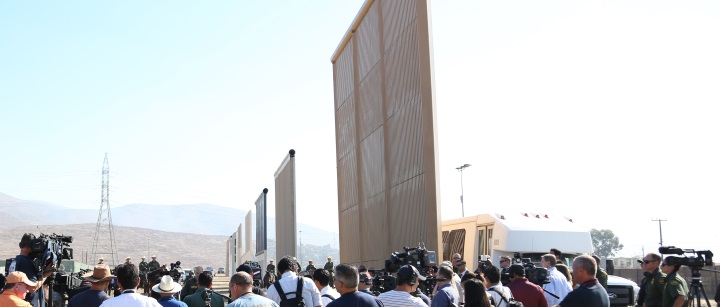
President Donald Trump cited a contested report from an organization that advocates low immigration to claim that a wall along the southern border will pay for itself, because those stopped from illegally crossing would not be a burden on taxpayers.
The report, from the Center for Immigration Studies, relies on data extrapolated from a report by the National Academies of Sciences, Engineering, and Medicine, or NAS. Several of those who created the NAS report, however, say their data are being misused, and that keeping out those who cross the border illegally might actually cost the government money over time.
We caution that estimating the cost of immigrants well into the future is highly speculative business, and requires a number of assumptions. Reasonable people may disagree about which assumptions are most appropriate. But it is notable that several members of the NAS panel object to the way their data were used to support the president’s claim.
Trump first forwarded the claim via a retweet of a quote from a Fox News Story.
“According to the Center for Immigration Studies, the $18 billion wall will pay for itself by curbing the importation of crime, drugs and illegal immigrants who tend to go on the federal dole…” https://t.co/NdLC6jZwWE
— Donald J. Trump (@realDonaldTrump) March 13, 2018
https://platform.twitter.com/widgets.js
The same day, in remarks in San Diego after reviewing border wall prototypes, Trump put that claim in his own words.
The wall, Trump said, “will save thousands and thousands of lives, save taxpayers hundreds of billions of dollars by reducing crime, drug flow, welfare fraud, and burdens on schools and hospitals. The wall will save hundreds of billions of dollars — many, many times what it’s going to cost.”
First, let’s get to the origin of the claim.
The Fox News story cited as its source a study from the Center for Immigration Studies, or CIS, a group that advocates low immigration. A Feb. 15, 2017, study, “The Cost of a Border Wall vs. the Cost of Illegal Immigration,” by Steven Camarota, director of research for CIS, does conclude that “if a border wall stopped a small fraction of the illegal immigrants who are expected to come in the next decade, the fiscal savings from having fewer illegal immigrants in the country would be sufficient to cover the costs of the wall.”
The CIS report puts the average lifetime cost to local, state and federal governments of border-crossers — the cost of government benefits minus taxes paid — at $74,722 in today’s dollars per person. CIS then assumes a border wall would prevent 160,000 to 200,000 illegal crossings in the next 10 years. Therefore, it concludes, the net savings would be $12 billion to $15 billion, enough to pay for the wall. The CIS report counts those savings upfront, even though it would take decades to accrue. (Also, the White House has since requested $18 billion for what it calls the first phase of the wall construction.)
As we said, these kinds of economic estimates are speculative and require researchers to make numerous assumptions. So let’s look at the ones CIS made, and which several members of the National Academies panel contest.
CIS extrapolates data from a 2016 NAS report, “The Econonomic and Fiscal Consequences of Immigration,” by the National Academies of Sciences, Engineering, and Medicine. The 500-page report was the consensus of a panel appointed by the NAS to answer, among other questions, what impact immigration — legal and illegal — is having on federal, state and local budgets. The 18-member panel consisted of economists, sociologists, demographers and public policy experts.
The NAS report concluded that “first-generation immigrants are more costly to governments, mainly at the state and local levels, than are the native-born, in large part due to the costs of educating their children. However, as adults, the children of immigrants (the second generation) are among the strongest economic and fiscal contributors in the U.S. population, contributing more in taxes than either their parents or the rest of the native-born population.”
The NAS panel considered eight different scenarios, each of which had different assumptions about future government spending and tax rates. Projecting future budgets is the biggest uncertainty in the report, and it affects the results greatly.
Camarota said he chose to take an average of those eight NAS scenarios. And he also decided not to include the net cost, or benefit, of the second generation children born to those who crossed the border illegally.
It is those two decisions that lie at the crux of the criticism of Camarota’s report.
Averaging the scenarios “makes no sense,” said Gretchen Donehower, a researcher in the Department of Demography at the University of California at Berkeley, who was hired as a consultant to the NAS panel to do calculations on the fiscal impact of immigrants.
“An average is appropriate when you have similar things with variation and you are trying to get a central tendency,” she said. “Our eight scenarios are completely different ways of thinking about the question. They are averaging not just apples and oranges, but watermelons and blueberries and saying the answer tells you something about fruit.”
Donehower also criticized the CIS decision not to include the contribution of future children of immigrants who may offset the net cost of the parents. Camarota said he decided not to include the children of border-crossers because the fiscal impact for those children was considered over the next 75 years. Camarota argued such a long time frame is too “speculative.”
“Well, the whole exercise is speculative,” Donehower said. “We include 75 years of projected taxes and benefits for the immigrant and for his/her children, the cost of children 75 years from now is no less speculative than the cost of the immigrant 75 years from now. I don’t see the justification for leaving them out as legitimate.”
Donehower believes the most reasonable scenario to use when estimating the cost of illegal immigration would be one in which immigrants are not assumed to contribute to an increase in the cost of such things as defense spending or interest on the national debt. She said “keeping 200,000 people out over the next ten years will likely not lower defense budgets, for example.”
She also believes it makes sense to use the Congressional Budget Office’s long-term budget outlook, which assumes legislators will at some point rein in the deficit spending of our current path. Other scenarios assume there are no budget adjustments, and that debt is allowed to explode over time. In that scenario, the estimated cost of providing government services would go up for every American, as well as the cost of every new immigrant.
Under those assumptions, the children of immigrants are net contributors to the federal coffers, and more than offset the cost of their parents.
“Given that set of choices, and taking the CIS guess at the educational attainment of an illegal border crosser, my calculation is that each immigrant prevented by a wall would COST the government about $8,000,” Donehower said.
Camarota argues that Donehower has chosen the only scenario that produces positive results.
“By averaging them all, I do not privilege any one scenario over the other seven,” Camarota said. His report, he said, “moderates the extreme values, which makes sense given all the uncertainty about the future.”
Kim Reuben, a senior fellow at the Tax Policy Center and one of the NAS panelists, agrees with Donehower that averaging the scenarios is inappropriate.
“Certainly, some scenarios are more relevant than others,” Reuben said.
Reuben agreed with the assumptions made by Donehower, noting that if you don’t include the cost/benefit of the inevitable children born to border-crossers, you are counting the cost to educate them but not the benefit of the taxes they pay once they enter the workforce.
“In my mind, adding $12 billion or $15 billion to pay for a wall is not realistically going to be a revenue-generating activity,” Reuben said.
Others on the panel — including Jeffrey Passel of the Pew Research Center and Christopher Mackie, the NAS study director who coordinated the panel’s efforts — questioned the CIS’ assumption that the wall would stop 160,000 to 200,000 illegal border crossings over the next decade.
Camarota said his estimate was based on stopping 9 percent to 12 percent of those expected to successfully cross in the next decade, based in part on recent apprehensions. Passel counters that fewer unauthorized immigrants from Mexico and Central America are “settling” in the U.S. (as opposed to crossing temporarily and returning) and so fewer long-term immigrants would be stopped by a border wall.
Mackie, the study director, said the CIS math only addresses the fiscal cost of immigration and that “there is also an economic/labor market cost to slowing immigration. To the extent that the wall would decrease immigration, it would shrink the economy, especially given the current demand for low-skill workers in certain industries (construction, food processing, farming).”
“This calculation by CIS is not a fair or accurate use of the report’s findings,” Mackie told us in an email.
We should also note that nothing in the CIS analysis (nor the NAS report) is related to the cost of drugs or crime, as Trump and the Fox News story suggested.
Again, we are talking about estimates for the fiscal cost or benefit of immigrants, and those numbers are based on assumptions about future spending and taxes, and immigration trends, among other things. And in this case, several members of the NAS panel dispute the conclusions of the CIS report cited by President Trump. Readers would be wise to take the claim with a grain of salt.
The post Will Trump’s Wall Pay for Itself? appeared first on FactCheck.org.

